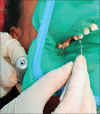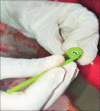Effect of silver diamine fluoride, potassium nitrate, and glutaraldehyde in reducing the post vital tooth preparation hypersensitivity: A randomized controlled trial
- PMID: 36511025
- PMCID: PMC9132512
- DOI: 10.4103/jips.jips_254_21
Effect of silver diamine fluoride, potassium nitrate, and glutaraldehyde in reducing the post vital tooth preparation hypersensitivity: A randomized controlled trial
Abstract
Aim: Hypersensitivity is the most common clinical problem which is encountered by most of dental patients undergoing a vital tooth preparation for a fixed crown prosthesis. The aim of this study is to evaluate the effect of silver diamine fluoride, potassium nitrate, and glutaraldehyde in reducing dentinal hypersensitivity following vital tooth preparation.
Settings and design: This study is a randomized control trial performed on 119 teeth of 68 patients who are in need of fixed prosthesis treatment.
Materials and methods: After a thorough clinical examination, patients were allocated into any of the randomly assigned four groups (Control, silver diamine fluoride, potassium nitrate, and glutaraldehyde) and the level of hypersensitivity was measured by blasting air on the surface of tooth at five different intervals (before preparation, after preparation, after application of desensitizers, before cementation and after a follow up period of about 30 days) and is graded using Schiff 's cumulative hypersensitivity index.
Statistical analysis used: Kruskal wallis test is used to compare the rate of sensitivity between the 4 groups. Friedman and Wilcoxon test is used to compare the rate of sensitivity at 5 different intervals.
Results: All the desensitizers used in this study reduced the level of hypersensitivity. Among which, silver diamine fluoride was found to be more effective after application, before cementation, and after a follow up period of about 30 days followed by GLUMA and potassium nitrate.
Conclusion: The results of this study suggest that silver diamine fluoride was found to be more effective after application, before cementation of the definitive prosthesis and after a follow up period of 30 days.
Keywords: Dentinal hypersensitivity; desensitizers; vital tooth preparation.
Conflict of interest statement
None
Figures








References
-
- Holland GR, Narhi MN, Addy M, Gangarosa L, Orchardson R. Guidelines for the design and conduct of clinical trials on dentine hypersensitivity. J Clin Periodontol. 1997;24:808–13. - PubMed
-
- Porto IC, Andrade AK, Montes MA. Diagnosis and treatment of dentinal hypersensitivity. J Oral Sci. 2009;51:323–32. - PubMed
-
- Addy M. Dentine hypersensitivity: New perspectives on an old problem. Int Dent J. 2002;52:367–75.
-
- Amarasena N, Spencer J, Ou Y, Brennan D. Dentine hypersensitivity in a private practice patient population in Australia. J Oral Rehabil. 2011;38:52–60. - PubMed
Publication types
MeSH terms
Substances
LinkOut - more resources
Full Text Sources

